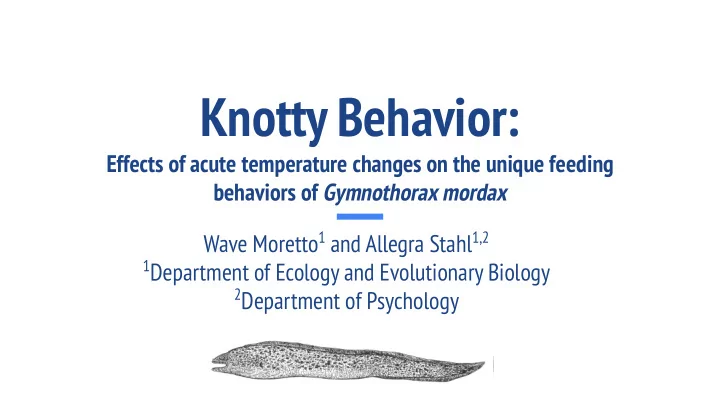

Knotty Behavior: Effects of acute temperature changes on the unique feeding behaviors of Gymnothorax mordax Wave Moretto 1 and Allegra Stahl 1,2 1 Department of Ecology and Evolutionary Biology 2 Department of Psychology
Background ● Interannual variability - El Niño Southern Oscillation & Pacific Decadal Oscillation ● "The Blob" appeared off the coast of California in the winter of 2013 – 2014 ● Shifts in Coastal Fish Distributions, (i.e. Largemouth Blenny (Love et al, 2016)) ● Ectotherms are especially sensitive to thermal changes in environment ○ As temperature increases viscosity decreases → thermal dependence on mouth movements (Devries et al, 2006) ○ Rate of motion expected to double for every 10 °C increase in temperature” (Turingan et al, 2016)
Introduction ● Examine relationship between acute temperature changes and moray eel feeding behaviors ● Knotting is time intensive, and enables morays to handle larger prey items or eat in chunks (Diluzio, 2017) Question: ● Do acute changes in water temperature affect predatory behavior? ● Predictions: ○ Increase in time intensive behaviors (knotting, spinning) at higher temperatures ○ Knotting and spinning behaviors will be faster at higher temperatures
Methods ● 6 Gymnothorax mordax (CA Morays) from Catalina Island, Ca ● Fed every two weeks, prey, (squid, n=5) 15% total body mass ● Exposed to 1 of 4 temperatures each feeding → trials randomized using a Latin Square Design ○ 15° C (Monterey Bay) 18° C (Winter Catalina) 21° C (Summer Catalina) 24° C (Summer Baja) ○ At least 3 trials at each temperature ● Acclimate in test tank 20 minutes before trial begins ● Film feeding at 120 FPS and analyze videos in iMovie ● Determine differences in prey handling behaviors across temperature treatments using ANOVAs in JMP Pro 14
Behavioral Results Shaking Ramming Spinning Knotting
Preliminary Results Using ANOVAs ● No difference between prey Level F-statistic P-Value handling time and temperatures Temp vs ln trial duration 0.452 0.7182 ● No difference between total shaking Temp vs collective knotting 1.7816 0.1764 duration or total spinning duration Temp vs ln Collective time and temperature spent ramming 3.1714 0.0417 Temp vs ln Collective time ● Number of knotting boughts spent spinning 0.122 0.9463 differed significantly across Temp vs ln Collective time spent shaking 0.3748 0.7719 temperatures Temp vs # Knots 3.0573 0.0468 ○ # of knots was highest in summer Baja ● Total time ramming prey differed Temp vs # Rams 1.4698 0.2468 significantly across temperatures Temp vs # Spins 0.4576 0.7143 ○ Ramming time highest in Monterey Bay Temp vs # Shakes 0.1924 0.9006 ○ Lowest in summer Baja
Future Directions ● Continue with feeding trials and behavioral analyses ● Examine feeding behaviors in the field ● Conduct trials where morays gradually transition into different temperature regimes
Acknowledgements Dr. Rita Mehta, Trevor Wang, Kyle Donohoe, Team Moray Summer 2019, Rachel Carson Student Project Fund; USC Wrigley Center for Environmental Studies; CDFW Permit SC-11366 and S-190830002-19086-001
Questions?
References Barley, S. C., Mehta, R. S., Meeuwig, J. J., & Meekan, M. G. (2016). To knot or not? Novel feeding behaviours in moray eels. Marine Biodiversity , 46 (3), 703–705. https://doi.org/10.1007/s12526-015-0404-y Climate Change Literature—Moray Knotting Behavior—Google Drive . (n.d.). Retrieved March 9, 2020, from https://drive.google.com/drive/folders/1n5mR3f1_NjF5N0BKcZs79RnPbH7imPzb Devries, M. S., & Wainwright, P. C. (2006). The Effects of Acute Temperature Change on Prey Capture Kinematics in Largemouth Bass, Micropterus Salmoides. Copeia , 2006 (3), 437–444. https://doi.org/10.1643/0045-8511(2006)2006[437:TEOATC]2.0.CO;2 Diluzio, A. R., Baliga, V. B., Higgins, B. A., & Mehta, R. S. (2017). Effects of prey characteristics on the feeding behaviors of an apex marine predator, the California moray (Gymnothorax mordax). Zoology , 122 , 80–89. https://doi.org/10.1016/j.zool.2017.03.002 Effects of climate ‐ driven primary production change on marine food webs: Implications for fisheries and conservation—BROWN - 2010—Global Change Biology—Wiley Online Library . (n.d.). Retrieved March 9, 2020, from https://onlinelibrary.wiley.com/doi/10.1111/j.1365-2486.2009.02046.x Hansen, J., Sato, M., Ruedy, R., Kharecha, P., Lacis, A., Miller, R., Nazarenko, L., Lo, K., Schmidt, G. A., Russell, G., Aleinov, I., Bauer, S., Baum, E., Cairns, B., Canuto, V., Chandler, M., Cheng, Y., Cohen, A., Genio, A. D., … Zhang, S. (2007). Dangerous human-made interference with climate: A GISS modelE study. Atmospheric Chemistry and Physics , 7 (9), 2287–2312. https://doi.org/10.5194/acp-7-2287-2007 Malcolm, H. A. (2016). A moray’s many knots: Knot tying behaviour around bait in two species of Gymnothorax moray eel. Environmental Biology of Fishes , 99 (12), 939–947. https://doi.org/10.1007/s10641-016-0535-4 Mantua, N. J., & Hare, S. R. (2002). The Pacific Decadal Oscillation. Journal of Oceanography , 58 (1), 35–44. https://doi.org/10.1023/A:1015820616384 Mehta, R. S., Ward, A. B., Alfaro, M. E., & Wainwright, P. C. (2010). Elongation of the Body in Eels. Integrative and Comparative Biology , 50 (6), 1091–1105. https://doi.org/10.1093/icb/icq075 Miller, T. J. (1987). Knotting: A Previously Undescribed Feeding Behavior in Muraenid Eels. Copeia , 1987 (4), 1055–1057. JSTOR. https://doi.org/10.2307/1445576 Miller, T. J. (1989). Feeding Behavior of Echidna nebulosa, Enchelycore pardalis, and Gymnomuraena zebra (Teleostei: Muraenidae). Copeia , 1989 (3), 662–672. JSTOR. https://doi.org/10.2307/1445493 Ng, T. P. T., Lau, S. L. Y., Seuront, L., Davies, M. S., Stafford, R., Marshall, D. J., & Williams, G. A. (2017). Linking behaviour and climate change in intertidal ectotherms: Insights from littorinid snails. Journal of Experimental Marine Biology and Ecology , 492 , 121–131. https://doi.org/10.1016/j.jembe.2017.01.023 Sanford, E. (1999). Regulation of Keystone Predation by Small Changes in Ocean Temperature. Science , 283 (5410), 2095–2097. https://doi.org/10.1126/science.283.5410.2095 Stenseth, N. C., Mysterud, A., Ottersen, G., Hurrell, J. W., Chan, K.-S., & Lima, M. (2002). Ecological Effects of Climate Fluctuations. Science , 297 (5585), 1292–1296. https://doi.org/10.1126/science.1071281 Turingan, R., & Sloan, T. (2016). Thermal Resilience of Feeding Kinematics May Contribute to the Spread of Invasive Fishes in Light of Climate Change. Biology , 5 (4), 46. https://doi.org/10.3390/biology5040046 When we share, everyone wins . (n.d.). Creative Commons. Retrieved March 9, 2020, from https://creativecommons.org/
Recommend
More recommend